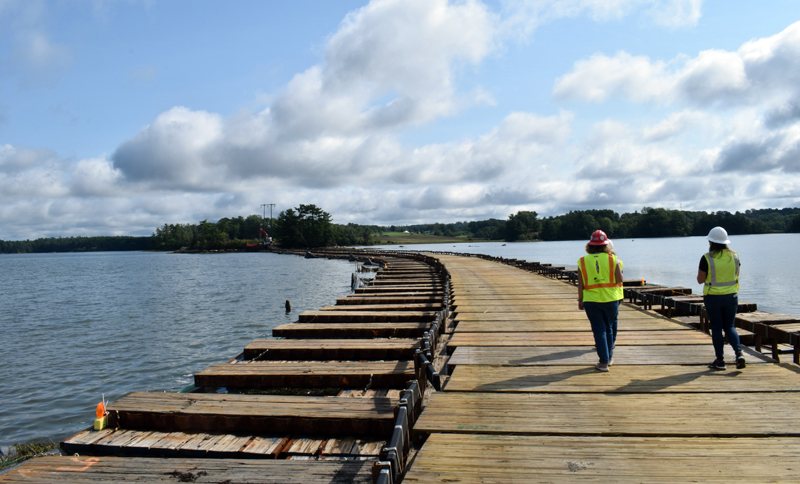
LCN editor Raye Leonard walks with Central Maine Power Co. Project Manager Nicole Harbaugh and CMP spokesperson Catherine Hartnett on the power company’s “floating road” in Great Salt Bay in Newcastle on Friday, Sept. 10. The road was used to access an island for repairs and will be taken out this week. (Evan Houk photo)
Central Maine Power Co.’s repairs on an island in Great Salt Bay, which required the construction of a temporary “floating road” for access, are nearly complete.
CMP expects to begin taking apart the road this week after replacing an H-frame structure on the island that dates to 1967, said CMP Project Manager Nicole Harbaugh, during a tour of the work site on Friday, Sept. 10.
The floating road is an advanced engineered wetland access system, first developed at the University of Maine that consists of floating pontoons covered with wooden mats that allow CMP vehicles access to the island.
“In essence, that’s what it is, a large pontoon going across the bay,” Harbaugh said.
Crews constructed the road in three-and-a-half weeks, faster than the anticipated six weeks. “The methodology of actually constructing this and watching as they just got closer and closer every day was great,” Harbaugh said.
The transmission line is a radial line that runs across the state-owned island and travels 10 miles from the Damariscotta Mills substation to the Bristol substation and provides power to approximately 4,300 customers in Newcastle, Bristol, and Damariscotta.
“A radial line means it goes in one direction and everyone down the line is dependent on it. So, if there’s an outage where it starts, everybody from there down is affected,” CMP spokesperson Catherine Hartnett said.
Harbaugh noted that no power outages were necessary to complete the work.
“This is a project where line workers have to do this work hot,” she said.
On Friday, crews were drilling the holes to place the new structure in. After the new structure was set, crews transferred the lines from the old H-frame. The new structure is 17-feet taller to meet modern federal requirements.
Newcastle signed a lease agreement with CMP in March 2020 to allow the company to use the town’s sand storage area off Mills Road as an access point to the island. In exchange, CMP provided distribution pole work for the town’s Academy Hill project.
CMP cleared an area on the site to access the water. The power company plans to restore the site to its original state after removing the floating road, which is expected to take between three and three-and-a-half weeks.



